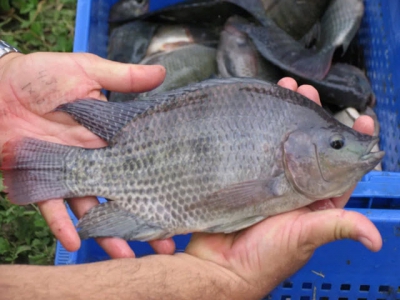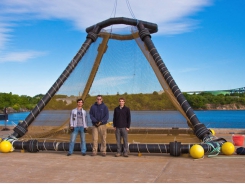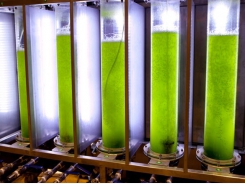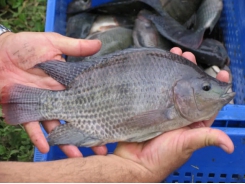10 paths to low productivity and profitability with tilapia in sub-Saharan Africa (Part 2)

Because tilapia will only grow up to its genetic potential under the best of culture conditions, the only way to grow much bigger or faster growing tilapia is to begin with a stock of the best strain. Photo by Darryl Jory.
5: Disease
One of the advantages of low intensity pond-based farming is the relatively low incidence of diseases. In fact, it is not widely verified that disease-driven mortality in ponds is significant in SSA compared to predatory pests such as bull frogs, snakes and birds, other fish including larger tilapia, poor water quality, or just high natural mortality of fry stocked very small.
Nevertheless, some farmers report increasingly high mortality in ponds and in the mix of possible causes is disease. Disease agents may be tracked into ponds through broodstock, fingerlings, the sources of pond water, or other pond inputs such as feed. Good pond preparation including drying and sanitizing helps but a major origin of diseases is uncontrolled introduction of aquatic animals (alive or dead) bypassing quarantine measures. Effective oversight of introductions and importations and certification of hatcheries is a vital role of government in the public interest.
6-9: Shallow ponds, inadequate feeds and suboptimal feeding and fertilization strategies
Next to the fish themselves, the pond environment and its management (i.e., fertilization, feeding, and water quality maintenance) greatly impact fish health, growth and productivity. The dosing of lime, fertilizer and other pond inputs is frequently based on surface area of a pond with the implicit assumption that the pond water is approximately 1 to 1.5 meters deep.
Observations in Ghana, however, have revealed that 80 percent or more of ponds are less than 1 meter deep and the average water depth of small-scale tilapia ponds is less than half a meter. Carrying capacity of shallower ponds is proportionally smaller, temperature swings through the day can be very extreme, and dosing of inputs can be off by significant margins. All these factors would lead to unstable water environment, reduced growth and mortalities.
Various combinations of green water production and supplementary feeding technologies continue to be shown as cost-saving alternatives to complete feeding. Yet, excessive feeding of expensive high-protein feeds to Nile tilapia is pervasive among farmers in SSA who can afford the feed.
On the flipside the common, less expensive, home-made powdery or sinking pellets that disintegrate quickly in water go to create more water quality problems in ponds than they serve as direct feed to fish. The cumulative result in these ponds regardless of the genetic potential of the fish stocked is slow growth and high mortality.
Standards of pond construction and maintenance need to be widely improved in SSA, with particular attention to appropriate pond depth. They should be drainable, regardless of pond size. Use recommended fertilization to grow fish largely on green water up to 100 to 150 grams and remaining grow-out should be based on low-protein feeds (e.g., 25 percent) and other techniques such as alternate-day feeding.
Observe fish and do not feed if fish are not feeding. These fertilization and feeding strategies may require a little more time to reach an ultimate size of about 250 to 300 grams, compared to full-ration commercial feeds but is well worth the cost savings.
10: Lack of market
Market is the only one of the 10 root causes of low productivity and profitability that the farmer does not control. It is advised to not site a farm or start production without knowing your market. Sadly, too may small-scale fish farmers in SSA have adopted fish farming initially through development aid programs that promoted subsistence farming; location of farms has therefore not considered market as a significant factor.
Farmers’ objectives invariably evolve over time toward financial profitability. In Ghana, over the last decade, pond-based farmers have chased the mirage of growing large tilapia, 400 grams or bigger, for restaurants, hotels and urban food joints, a niche already filled by cage farms and importers of whole frozen tilapia. In an attempt to achieve large sizes, fish are held in ponds for long periods (eight to nine months or longer) and of course those sizes are never achieved. Holding and feeding fish when they are not growing escalates FCR and adds to production cost.
Stocked at the right size, tilapia fingerlings will achieve most of their growth in less than six months. In most of warm SSA, at least two production cycles per year is feasible at a harvest size of 250 to 300 grams, with improved FCR. At these sizes, a higher stocking density can be used to boost production in a finite pond volume (i.e., productivity).
Egypt and Bangladesh produce large volumes of Nile tilapia that are harvested at 250 to 300 grams. The key to their success is efficiency in volume, not the size of the individual fish. On market, target the right rural, local and suburban consumers who will accept the size of fish you can grow and also do not plan to look for buyers only after the crop is ready.
Lastly, I emphasize the importance of good record keeping at both the farm and state level. Methods used to estimate productivity of small-scale farms in SSA by national extension services need to be more thorough and transparent. It may well be that data inaccuracies and data recycling contribute to the general perception of low productivity of tilapia ponds in sub-Saharan Africa. To the extent that productivity and profitability are truly low, better management practices can help to a large extent to reverse the course.
Có thể bạn quan tâm
Phần mềm

Phối trộn thức ăn chăn nuôi

Pha dung dịch thủy canh

Định mức cho tôm ăn

Phối trộn phân bón NPK

Xác định tỷ lệ tôm sống

Chuyển đổi đơn vị phân bón

Xác định công suất sục khí

Chuyển đổi đơn vị tôm

Tính diện tích nhà kính

Tính thể tích ao hồ




 Columnaris Disease
Columnaris Disease  10 paths to low productivity and profitability with…
10 paths to low productivity and profitability with…